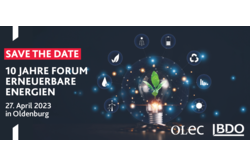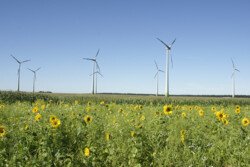
The current available adviser draft to the EEG amendment 2021, which is to be decided after a conceivably short federation participation phase of scarcely 3 weeks already today in the cabinet, does not satisfy the requirements of the country wide energy goals and the climatic neutrality. Improvements are urgently needed. To it the Oldenburger energy cluster OLEC registered association refers in its today's statement. The northwest is particularly affected by the lack of solutions for post-EEG plants, and there is also a lack of incentives for the improvement of green hydrogen and for general conditions for bioenergy. OLEC thus also fully supports the demands of the German Renewable Energy Federation (BEE) for substantial improvements in the sense of a clear commitment to climate protection and a future-oriented energy supply.
According to OLEC, the 2021 draft of the EEG does not contain any concepts and solutions for the sensible subsequent use of post-EEG plants, especially in the case of wind energy plants: "In Lower Saxony alone, plants with a total installed capacity of around 1,000 MW will already be affected in 2020 - by 2030 there is even a threat of a loss of almost 6,000 MW. In addition, the urgently needed expansion of new plants is stagnating for a variety of reasons. If we don't pick up speed again massively and now also eliminate urgently needed capacities without replacement, the energy turnaround will fall on our feet", warns OLEC CEO Roland Hentschel.
Ubbo de Witt, OLEC member of the board and wind park project manager of many years means: "It is not all gold which shines, but that in the future at the beginning of the EEG will stand that the use of renewable energies for the generation of current lies in the public interest and serves thus public security, is a large success. This will certainly also serve as a guideline for many administrative courts in the future in the direction of a forward-looking assessment of detailed problems in planning and approval law. However, the results of the last tenders have shown that of a possible 2,300 MW, only about 1,380 MW could be subsidized for onshore wind turbines. "There is still a lack of clear objectives in detail, e.g. for a repowering strategy whose positive effects of increasing electricity production while at the same time reducing the number of turbines are undisputed," Ubbo de Witt continued. A "nebulous mat-ching mechanism" must therefore be developed further in consultation with the experts in "Wind Land Number One" into a "continued operation mechanism" for the most economically profitable, depreciated old plants, in order to preserve locations and not jeopardize expansion targets. De Witt also points out that the green electricity property of wind power must be preserved and remain marketable in the region of the wind farms in order to enable direct marketing to the neighbouring electricity consumers* and thus increase acceptance on site.
OLEC criticizes that the current expansion targets and the annual target cor-ridors based on them are not suitable to meet the growing demand for CO2-free energy and to fulfill the goals of climate neutrality until 2050 of the German government. Especially not if the decarbonization of the transport sector is finally taken seriously and issues such as green hydrogen gain momentum. Sector coupling, electromobility, the use of hydrogen and digitization will foreseeably trigger a stronger demand for green electricity; the federal government's hydrogen strategy alone sees an additional demand of up to 5,000 MW by 2030. Roland Hentschel: "The Northwest can play a key role here, because the starting situation for the production, storage, transport and use of green hydrogen is more ideal than in any other German region. However, we are still a long way from achieving economic viability and thus market upturn". Here, too, the politicians urgently need to make adjustments.
OLEC also criticizes the fact that the present draft does not make any statements regarding the expansion of bioenergy, in particular the generation of electricity from liquid manure, waste and residual materials. The bad basic conditions of the bio energy are well-known for many years. The Northwest, which is strongly influenced by agriculture, is also strongly affected, but offers not only the raw material, but also a multitude of actors* and technologies. What is missing here is a reliable framework and target-oriented strategies for the reuse of old plants.
The energy system transformation is decentralized and diverse in its actors' structures, which makes the renewables sector particularly crisis-resistant. However, this advantage is not sufficiently used - in favor of old structures of an energy supply with rather few and large players. But now, all the more in view of the climate crisis, it is important to work with all players to design a new energy system that is decentralized and decentralized.
Translated with www.DeepL.com/Translator (free version)












